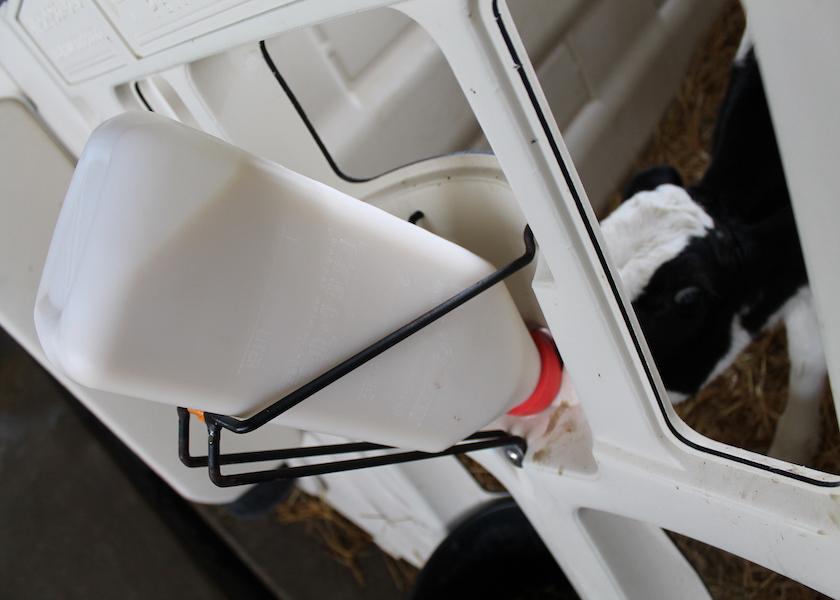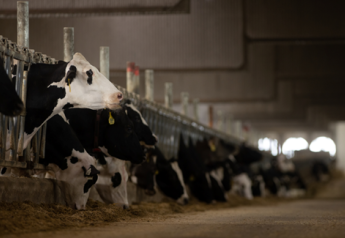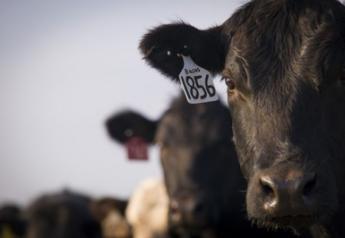The Pros and Cons of Using a Colostrum Replacer

Have you ever been in the situation where you need to feed a newborn calf, but the quality or the quantity of the maternal colostrum just isn’t going to cut it? It’s a scenario thousands of producers have gone through, but not every producer knows the easy solution using a colostrum replacer provides.
Prepackaged colostrum replacers are an easy way to quickly feed colostrum to a newborn calf. However, while they do come with many benefits, there are a few potential negative aspects of utilizing this nutritional tool. Sandra Godden, professor at the University of Minnesota College of Veterinary Medicine, and Tom Earleywine, Milk Replacer Director of Nutritional Services at Land O’Lakes, list out some of the pros and cons of using a colostrum replacer on your operation.
The Pros
Convenience
Producers can go through bouts when an adequate supply of high-quality fresh or frozen maternal colostrum is not available. Because delivering necessary immunoglobulins (IgGs) within the first few hours of birth is critical, utilizing a prepackaged, easy to mix colostrum replacer is a convenient way to ensure calves are getting the nutrition they need.
“The convenience of not having to harvest the colostrum right away or thaw out frozen colostrum is a big advantage for producers,” Earleywine says. “Any way we can speed up the process of getting colostrum to the calf is a good thing, and colostrum replacer gives producers the ability to feed colostrum right away.”
Additionally, using a colostrum replacer eliminates the need to harvest colostrum at inconvenient times, such as between milking shifts.
“If people are having challenges collecting the maternal colostrum in a timely manner, as well as doing so in a clean hygienic fashion, then the convivence of a colostrum replacer can be very attractive,” Godden adds.
Consistency
Delivering consistent, high-quality colostrum to your calves is essential to any calf management program. However, this is easier said than done as the quality of maternal colostrum can vary greatly from cow to cow. Ideally, calves should consume a minimum of 150g-200g of IgGs, and ideally closer to 300 g, in order to achieve acceptable passive transfer rates, but not all maternal colostrum contains these amounts.
“The thing about using a colostrum replacer is that it’s a very consistent product,” Earleywine notes. “The problem with maternal colostrum is that it can really range in quality and quantity. With a replacer, you know what you’re going to get each time.”
Cleanliness
Though feeding maternal colostrum does come with its list of perks, one down fall is not being able to control cleanliness as easily. While heat-treating maternal colostrum is encouraged, it does take additional time and not every producer has this resource. Also, it must be carefully monitored for correct time and temperature settings of the pasteurizer. In comparison, feeding a colostrum replacer ensures disease causing pathogens are not present during feeding.
“The cleanliness and absence of pathogens is useful to try to break disease transmission cycles for herds that are struggling with some diseases that might be transmitted through fresh maternal colostrum,” Godden says. “Examples of this include Mycoplasma spp., Salmonella spp. and Mycobacterium avium subsp. paratuberculosis (Johne’s Disease).”
The Cons
While feeding a colostrum replacer as needed is a valuable calf management tool, it does come with a few drawbacks producers should consider.
Feeding Lower Volumes
When feeding a maternal colostrum, delivering 3 to 4 L within the first few hours of birth is the gold standard. This provides a great deal of warmth and hydration to the newborn calf. However, when feeding a colostrum replacer, the total amount fed is often less. Therefore, you aren’t delivering the same amount of warm hydration which helps heat the calf up internally.
“Because you’re feeding a more concentrated product, often times you’re feeding a lower volume,” Earleywine says. “If you’re feeding a lower volume, then you’re reducing the amount of hydration and heat a maternal colostrum would typically provide.”
Cost
“The cost is the biggest issue for a lot of producers,” Godden notes. “Some of the higher quality replacers easily range from $30-$50 a dose, and one dose for many products may only contains somewhere between 100g-125g of IgGs. If we want to match what mom would have given the calf, we need to provide a minimum of 150g-200g of IgGs. So, giving multiple doses of a colostrum replacer can start to get pretty pricy.”
Though it’s important to pick a colostrum replacer that fits within your budget, both Godden and Earleywine advise producers to not select a colostrum replacer simply because it’s cheap.
“Like a lot of things, you get what you pay for,” Earleywine says. “I’m not saying cheaper colostrum replacers won’t work, but they probably aren’t the highest quality product. You just won’t see the same level of performance out of cheaper made products and you may end up having to feed more of them to get to the same dosage of IgGs.”
Do Your Colostrum Replacer Homework
While using a colostrum replacer is better than not providing any colostrum at all, it’s still important to do your research before selecting a product. Godden advises the following steps:
Know Your Why – “The first thing you want to do is know your why,” Godden says. “Why are you considering feedin a replacer? Is it something that makes sense for your operation? Is it a management tweak that’s going to show improvements? These are questions producers need to ask themselves before diving into the details.”
Figure Out Your When – If feeding a colostrum replacer is an option for your farm, Godden suggests setting up protocols as to when you need to utilize it.
“You need to decide when it’s best to use a colostrum replacer,” Godden notes. “Are you going to feed it to every calf? Are you going to feed it only when you don’t have maternal colostrum? Or are you going to supplement it into maternal colostrum when the quality isn’t high enough?”
Decide Your Goals – While the goal of every producer should be to feed the right amount of high-quality colostrum to the calf in a timely manner, that isn’t always the case. Hence, it’s important to determine what your colostrum goals are.
“If your goal is to just keep the calf alive, then feeding a minimum of 100g of IgGs will get the job done. But your goal really should be to provide 200g-300g of IgGs to help ensure adequate passive transfer,” Godden notes.
Find Your Product – Godden advises having a conversation with your veterinarian, nutritionist and/or a colostrum replacer representative to fully understand the nutritional benefits behind each product. You should have a conversation about whether a USDA licensed or non-licensed product is important to you, she suggests.
“Look for those products that have done the research and have some data behind their claims,” Godden notes. “You want to make sure your investment in these products is going to be worthwhile.”







